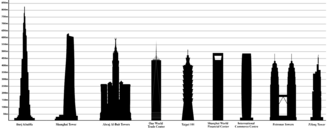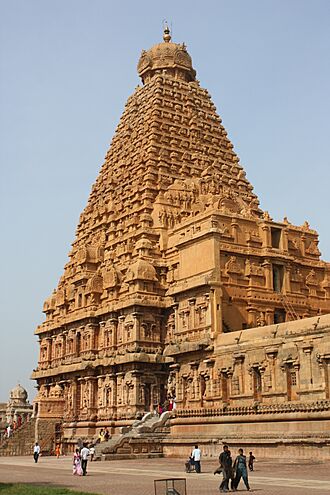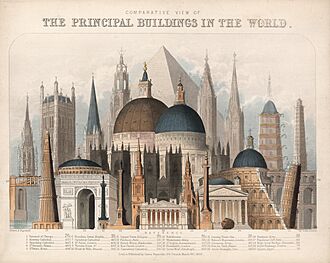History of the world's tallest buildings facts for kids
The tallest building in the world right now is the Burj Khalifa in Dubai. But the title of "world's tallest building" has changed many times throughout history! Famous buildings like the Lincoln Cathedral in Lincoln, England, and the Empire State Building and the original World Trade Center in New York City have all held this record.
Before modern skyscrapers were invented, most of the tallest buildings were Christian churches and cathedrals. This was true from about 1311 to 1884. Before that, it's hard to know for sure which buildings were the tallest. For example, the Lighthouse of Alexandria was built around 280 BC and might have been 100 meters (328 ft) tall, but we don't know its exact height. For thousands of years, the Great Pyramid in Egypt was the tallest structure in the world. But it's not considered a "building" because people didn't live or work inside it. The Eiffel Tower was also the world's tallest structure from 1889, but it wasn't the tallest building.
The first skyscraper was built in Chicago in 1884. It was called the Home Insurance Building. It used a steel frame and thin outer walls instead of thick, heavy walls. For the next 100 years, the world's tallest building was always in the United States. New York City had the tallest building for 86 years, and Chicago for 30 years. Then, in 1998, the record moved to Malaysia with the Petronas Towers. This was the first time a country outside the U.S. built the tallest building. Next, Taiwan's Taipei 101 held the record from 2004 to 2009. Finally, the Burj Khalifa in the United Arab Emirates became the tallest in 2009. It stands at 828 meters (2,717 ft) tall!
Contents
What is a "Building"?
When we talk about the "world's tallest building," we usually mean a structure where people live, work, or visit regularly. This is different from a "structure" like a radio tower or a monument.
The earliest very tall structures were the Egyptian pyramids. The Great Pyramid of Giza was about 146.5 meters (481 ft) tall when it was new. It was the tallest structure in the world for over 3,800 years! This was until Lincoln Cathedral was built in 1311. After that, until the Washington Monument was finished in 1884, the tallest structures were churches or cathedrals. Later, the Eiffel Tower and then radio and TV towers became the tallest structures.
But many of these tall structures are not "buildings" in the way we usually think of them. They don't have many floors where people live or work. The Council on Tall Buildings and Urban Habitat (CTBUH) is a group that sets rules for measuring tall buildings. They say a "building" must be designed for living, business, or making things, and it must have floors.
Churches and cathedrals are a bit in the middle. Their lower parts are used often, but much of their height is in bell towers and spires that people don't regularly occupy. For this article, we will count churches and cathedrals as buildings.
Tall Buildings Before the 20th Century
Ancient Wonders and Early Tall Structures


Very old tall buildings were like the famous Egyptian pyramids. Around 1400 BC, the 70-meter (230 ft) ziggurat of Dur-Kurigalzu was built in Mesopotamia. In 601 BC, the Etemenanki ziggurat of Babylon followed, at 91 meters (299 ft). The 70-meter (230 ft) La Danta in El Mirador (Guatemala) and the 73-meter (240 ft) Amaravati Stupa in Amaravati (India) were built around 300 BC.
The Lighthouse of Alexandria in Egypt was very tall, between 103 and 118 meters (338 and 387 ft). It stood for over 1,000 years, from the 3rd century BC to the 14th century AD.
The Pantheon in Rome, finished in the early 2nd century CE, was 43.45 meters (142.6 ft) tall inside. The Hagia Sophia, built in AD 537 in Constantinople, reached 55 meters (180 ft).
The ancient Kushan stupa of Kanishka, near Peshawar, Pakistan, was completed around AD 200. It was between 120 and 170 meters (394 and 558 ft) tall. A Chinese explorer named Xuanzhang called it the tallest building in the world. The Sri Lankan Jetavanaramaya stupa, built in the 3rd century, was 122 meters (400 ft) tall until the 11th century. Today, it is 71 meters (233 ft) tall.
Another tall but short-lived structure was the 6th-century wooden Yongning Pagoda. It was about 137 to 155 meters (449 to 509 ft) tall in Luoyang, China.
Hwangnyongsa, a former Buddhist temple in South Korea, was finished in the 7th century. This huge nine-story building was made entirely of wood without iron nails. It was 68 to 80 meters (223 to 262 ft) tall. This made it the tallest structure in East Asia and the tallest wooden structure in the world at that time. It was destroyed in 1238.
In the 8th century, two 100-meter (328 ft) tall pagodas were built at Todaiーji in Nara, Japan. They were among the tallest wooden buildings then. Both were later burned down by fires.
In 1057, the 100-meter (328 ft) wooden Shwesandaw Pagoda in Bagan, Myanmar, was built.
The Vimana of the Brihadisvara Temple, Thanjavur, Tamil Nadu, was completed in 1010. It is 66 meters (217 ft) tall, a bit taller and older than Angkor Wat in Cambodia. It is made of granite.
The 77-meter (253 ft) minaret of Koutoubia Mosque in Marrakesh, Morocco, was finished around 1195.
The eastern spires of the Romanesque Speyer Cathedral, finished in 1106, are 71.3 meters (234 ft) tall. The Torre Asinelli, finished before 1185, was first 70 meters (230 ft) tall, then raised to 92 meters (302 ft). Malmesbury Abbey was built in 1180 and reached 131 meters (430 ft).
Churches and Cathedrals: Tallest Buildings (13th to 20th Century)
From the 13th or 14th century until 1884, the world's tallest structures were churches or cathedrals. They were also the tallest buildings until the early 20th century. Old St Paul's Cathedral (149 meters / 489 ft) in London and Lincoln Cathedral (160 meters / 525 ft) both became taller than any previous building, even the Pyramids. They were finished around 1311-1314. Lincoln Cathedral's spire fell in 1549. For a long time, no other building was taller.
St. Mary's Church in Stralsund became the tallest after Lincoln's spire fell. The 153-meter (502 ft) central tower of St. Pierre's Cathedral in Beauvais was tallest from 1569 until it collapsed in 1573. Then St. Mary's was tallest again. In 1647, St. Mary's bell tower burned down, making the shorter Strasbourg Cathedral the world's tallest building.
It wasn't until Ulm Minster was finished in 1890 that a building was again taller than the original Lincoln Cathedral.
| Years Tallest | Name | Location | Height | Increase | Notes |
|---|---|---|---|---|---|
| 13th century–1311 | Old St Paul's Cathedral | London | 149 m (489 ft) | 0% | Finished in 1314. Spire fell in 1561. |
| 1311–1549 | Lincoln Cathedral | Lincoln | 159.7 m (524 ft) | 7.2% | Tallest building ever until 1890. Spire fell in 1549. |
| 1549–1569 | St. Mary's Church | Stralsund | 151 m (495 ft) | −5.4% | |
| 1569–1573 | St. Pierre's Cathedral | Beauvais | 153 m (502 ft) | 1.3% | Tower fell in 1573. |
| 1573–1647 | St. Mary's Church | Stralsund | 151 m (495 ft) | −1.3% | Bell tower burned down in 1647. |
| 1647–1874 | Cathedral of Our Lady of Strasbourg | Strasbourg | 142 m (466 ft) | −6% | |
| 1874–1876 | Church of St. Nicholas | Hamburg | 147 m (482 ft) | 3.5% | |
| 1876–1880 | Rouen Cathedral | Rouen | 151 m (495 ft) | 2.7% | |
| 1880–1890 | Cologne Cathedral | Cologne | 157.38 m (516.3 ft) | 4.2% | Washington Monument became tallest structure in 1884. |
| 1890–present | Ulm Minster | Ulm | 161.53 m (530.0 ft) | 2.6% | Eiffel Tower became tallest structure in 1889. |
In 1890, Ulm Minster became the tallest church ever built. But it was the last church to be the world's tallest building. That title went to the Philadelphia City Hall in 1894. This was the first skyscraper taller than 150 meters (492 ft).
Among all structures, the 169-meter (554 ft) Washington Monument took the record from churches in 1884. But just five years later, in 1889, the Eiffel Tower became much taller at 300 meters (984 ft). This started the "supertall" era. Buildings didn't reach these heights again until the Chrysler Building (319 meters / 1,047 ft) in 1930 and the Empire State Building in 1931.
Tallest Structures Since the 20th Century
Since the Washington Monument was finished in 1884, the world's tallest structure has usually not been the world's tallest building at the same time. One exception was from 1930 to 1954. The Eiffel Tower was passed by the Chrysler Building in 1930, and then by the Empire State Building in 1931. After that, other structures like the Griffin Television Tower became taller. The CN Tower in Toronto was the world's tallest free-standing structure for 32 years (1975-2007). Then it was passed by the Burj Khalifa. It was also the tallest tower until 2009, when the Canton Tower became taller.
Since the Burj Khalifa was finished in 2010, it has been both the world's tallest building and the world's tallest structure of any kind.
Skyscrapers: Tallest Buildings Since 1908
Since the first skyscraper taller than 150 meters (492 ft) was completed (either the Philadelphia City Hall in 1894 or the Singer Building in 1908), skyscrapers have always been the tallest buildings.
Early Skyscrapers and Their Heights
Before skyscrapers, some tall buildings existed, like those in Shibam (30 meters / 98 ft) or the Towers of Bologna (up to 100 meters / 328 ft). Buildings that are often called the first skyscrapers include:
- E. V. Haughwout Building: 24 meters (79 ft) tall, 5 floors, first to use a passenger elevator, built in 1857.
- Equitable Life Building: at least 40 meters (131 ft) tall, 9 floors, built in 1870.
- New York Tribune Building: 79 meters (259 ft) tall, 9 floors, built in 1875.
- Home Insurance Building: 42 meters (138 ft) tall, 12 floors, built in 1885.
- Manhattan Building in Chicago: 68.3 meters (224 ft) tall, 16 floors, built in 1891.
- Monadnock Building: 66 meters (217 ft) tall, 17 floors, built in 1891.
Later record-setting early skyscrapers include:
- New York World Building: 94 meters (308 ft), 1890.
- Manhattan Life Insurance Building: 106 meters (348 ft), 1894.
How Skyscrapers Grew Taller
After the first skyscrapers over 150 meters (492 ft), buildings kept getting taller. The Chrysler Building was the first to break the 300-meter (984 ft) mark. Then came the Empire State Building, which was the first building with over 100 floors. It is 381 meters (1,250 ft) tall and has 102 floors.
The World Trade Center was finished in 1971. Its North Tower was 417 meters (1,368 ft) tall, and the South Tower was 415 meters (1,362 ft). It was 36 meters (118 ft) taller than the Empire State Building. Two years later, the Sears Tower was built in Chicago. It stood at 442 meters (1,450 ft) with 110 floors, 25 meters (82 ft) taller than the World Trade Center.
The Petronas Towers were 452 meters (1,483 ft) tall, 10 meters (33 ft) taller than the Sears Tower (if you count the Petronas spires but not the Sears Tower's antennas). Each had 88 floors.
In 2004, Taipei 101 reached a new height of 508 meters (1,667 ft) with 101 floors. It was 59 meters (194 ft) taller than the Petronas Towers. The Burj Khalifa then surpassed Taipei 101 by 319 meters (1,047 ft) in 2009, making it 60% taller! It broke many skyscraper records and is almost twice as tall as the Empire State Building.
The CTBUH calls a building "supertall" if it is 300 meters (984 ft) or taller. A building is "megatall" if it is 600 meters (1,970 ft) or taller.
Where the Tallest Skyscrapers Are Built
In the past, most of the world's 100 tallest buildings were in North America. In 1930, 99 out of 100 were there! But this is changing. More skyscrapers are now being built in other parts of the world, especially in Asia. Today, 60 of the world's 100 tallest buildings are in Asia (including the Middle East). All six "megatall" skyscrapers are also in Asia.
What Are Skyscrapers Used For?
For a long time, most skyscrapers were used as offices. From 1930 to 2000, over 86% of tall towers were offices. But this is changing too. By 2010, less than half of the 100 tallest buildings were offices. Many are now used for homes (residential) or a mix of uses.
A "mixed-use" tall building has two or more main purposes, like offices and homes, or a hotel and shops.
Skyscrapers used mainly as hotels or homes are usually shorter than office or mixed-use buildings. Some of the tallest residential buildings are Central Park Tower, 111 West 57th Street, and 432 Park Avenue, all in New York City. The tallest hotels are the Gevora Hotel, the JW Marriott Marquis Dubai twin towers, the Rose Tower, and the Burj Al Arab, all in Dubai.
List of Historically Tallest Skyscrapers
This list shows the tallest buildings based on their "architectural top" (including spires, but not antennas). Other ways of measuring might give a different list.
| Years Tallest | Name | Location | Height | Increase | Title Held (Years) |
|---|---|---|---|---|---|
| 1894–1908 | Philadelphia City Hall | Philadelphia | 167 m (548 ft) | 0% | 14 |
| 1908–1909 | Singer Building | New York City | 192 m (630 ft) | 15% | 1 |
| 1909–1913 | Metropolitan Life Tower | 213 m (699 ft) | 11% | 4 | |
| 1913–1930 | Woolworth Building | 241 m (791 ft) | 13% | 17 | |
| 1930 | 40 Wall Street | 283 m (928 ft) | 17% | <1 | |
| 1930–1931 | Chrysler Building | 318.9 m (1,046 ft) | 13% | 1 | |
| 1931–1971 | Empire State Building | 381 m (1,250 ft) | 19% | 40 | |
| 1971–1973 | World Trade Center | 417 m (1,368 ft) | 9% | 2 | |
| 1973–1998 | Sears Tower | Chicago | 442 m (1,450 ft) | 6% | 25 |
| 1998–2004 | Petronas Towers | Kuala Lumpur | 452 m (1,483 ft) | 2% | 6 |
| 2004–2010 | Taipei 101 | Taipei | 510 m (1,670 ft) | 13% | 6 |
| 2010–present | Burj Khalifa | Dubai | 828 m (2,717 ft) | 62% | 15 |
Images for kids
See also
- History of tallest skyscrapers
- List of tallest buildings and structures
- List of Egyptian pyramids
- List of tallest buildings
- List of tallest church buildings
- List of tallest structures built before the 20th century
- List of oldest known surviving buildings







